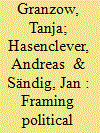| Srl | Item |
| 1 |
ID:
144453


|
|
|
|
|
| Summary/Abstract |
How do religious civil wars evolve? Many violent conflicts are fought between groups of different faiths. The paper argues, however, that religious differences rarely directly lead to conflict onset. Rather, the apparent religious dimension of many civil wars is a consequence of successful religious framing. Political and military leaders offer religious interpretations designed to legitimize the use of force and to mobilize believers to violent action. Such framing processes can be more or less successful, depending inter alia on the authority of the political and religious leadership, on the coherence and appropriateness of the frames, on the existence of persuasive counter-frames, and on the availability of communication infrastructures that allow for effective dissemination of religious frames. Comparing violent conflicts in the Philippines and Thailand, the paper shows that religious mobilization can fail along the theoretically predicted lines.
|
|
|
|
|
|
|
|
|
|
|
|
|
|
|
|
| 2 |
ID:
144448


|
|
|
|
|
| Summary/Abstract |
The papers of the special issue analyse intra-state conflict escalation and armed rebellion from a framing perspective. Following Robert Benford and David Snow, framing is understood as strategic communication to mobilise a constituency for political action through persuasive ‘collective action frames’.1 Such collective action frames comprise the identification of common grievances and responsible actors (diagnostic frame), possible solutions to the identified problems (prognostic frame) and sufficiently strong reasons to push a constituency into political action (motivational frame). In our understanding, ‘collective action frames’ can mobilise people for various forms of contentious behaviour (including armed rebellion), but they can also fail to resonate with the audience. Thus, we expect political violence to occur only if framers make a convincing and resonant ‘call to arms’. In order to show that collective action frames indeed matter for various forms of political violence and most importantly civil war, the special issue investigates two aspects in detail: First, the contributions trace the selection and development of collective action frames (in particular those that propagate violence) and analyse the framing strategies deployed by movement leaders. Second, the authors of this special issue seek to explain why some ‘calls to arms’ resonate and make a constituency support an armed group, whereas others fail to ‘sweep the audience’.
|
|
|
|
|
|
|
|
|
|
|
|
|
|
|
|